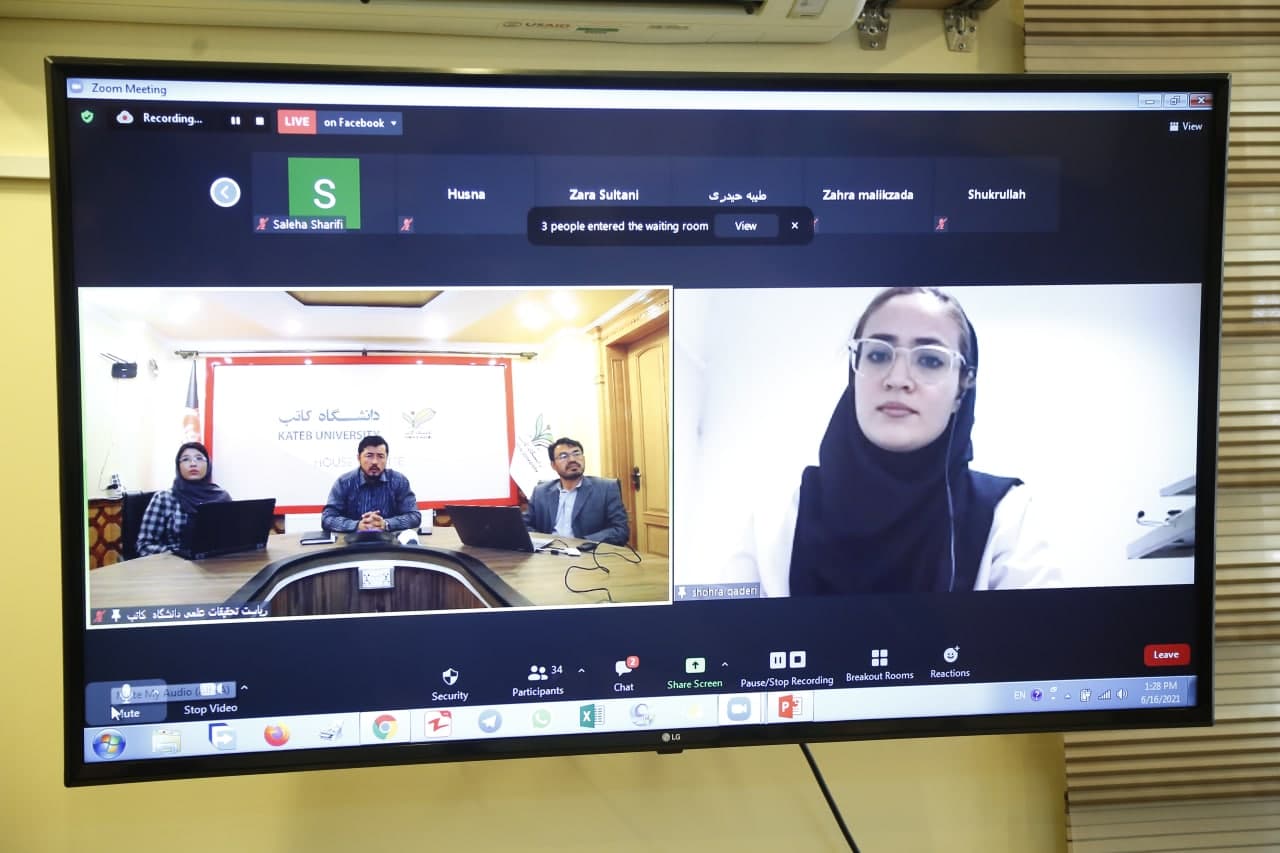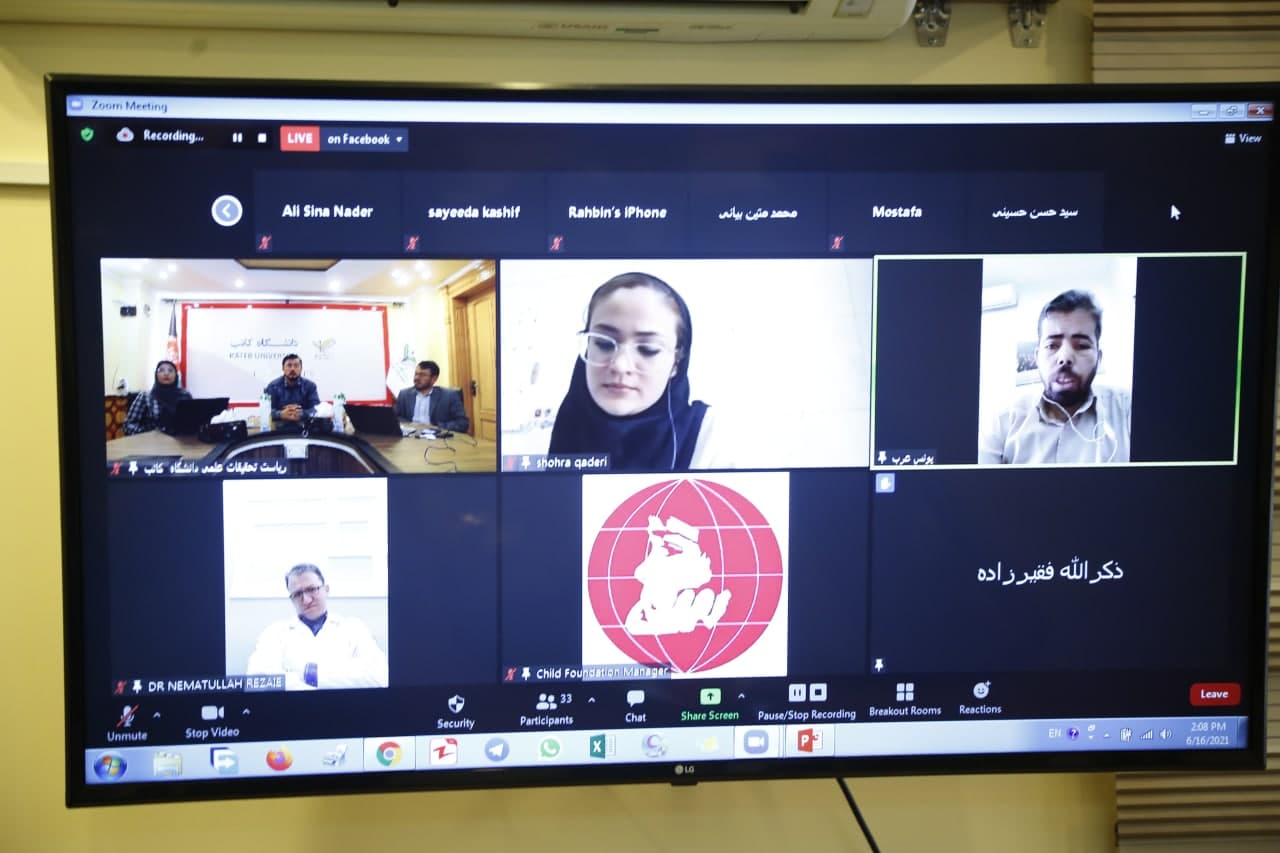On Wednesday, June 14th, 2021, coincides with World Blood Donation Day, a webinar entitled “Health and Social Challenges of Blood Donation in Afghanistan” was held. This webinar was organized by the Medical Research Center in collaboration with the Medicine Faculty of Kateb University. This webinar was attended by represents from government agencies and health NGOs.
The webinar began with the speech of Dr. Mousavi, head of Research Center at Kateb University who talked about the agenda of the webinar. Then Mr. Younes Arab, Chair of the Iranian Thalassemia Association, spoke about the challenges of blood donation and the needs of thalassemia patients. Mr. Arab said: “Considering that more than 1000 Afghan patients in Iran are receiving medical services and treatments, in order to prevent the forced migration of these people, it is necessary to first start genetic screening centers in Afghanistan, especially thalassemia throughout the country, along with instructions which should be approved by the parliament and the office of the president. On the other hand, immediate action should be taken by setting up independent blood donation bases in different parts of the country for immunization, screening, and purification, as well as providing healthy blood for 3 to 7 days for thalassemia patients.”
Then, Mr. Mojtaba Mohammadi, in charge of the thalassemia department of the Children’s Foundation, presented information about the standard stages of blood donation and its problems for thalassemia patients in Afghanistan. Regarding the standard stages of blood, Mr. Mohammadi said that since thalassemia is one of the special diseases, patients with thalassemia should also go through special steps to obtain and transfuse blood in public hospitals with special facilities. Cooperation of blood banks, cooperation of community members to donate blood, decomposition of blood cells in blood banks and injection of red blood cells into this type of patients, free tests (Ferritin) to detect excess iron in government laboratories, and continuous prescription of desirox tablets is necessary for these patients to take blood transfusions properly.
Mr. Mohammadi complained about the lack of blood in the blood bank of the country’s hospitals and the lack of blood donation culture among the people and especially the lack of proper management and careless planning of the Ministry of Public Health and the Central Blood Bank in informing about blood donation and launching blood donation.
Mr. Mohammadi pointed out that due to the lack of careless planning to attract people due to blood donation and the lack of most blood groups in the blood bank, most of the time we have been witnessed of the death of children with thalassemia. Mohammadi added that the Afghanistan Children’s Charity Foundation (Children’s Foundation) headed by Maryam Karimi, with more than 10 years of experience as a collaborator with public health officials in the northern zone in Mazar-e-Sharif, launched blood donation campaigns for children with thalassemia. This campaign has established the culture of blood donation in Balkh and every year, in order to promote this useful program, blood donation campaign programs are held in different parts of Mazar-e-Sharif.
Lack of blood counters, lack of laboratory services to detect excess iron (Ferritin) in thalassemia patients in hospitals and public laboratories, high cost of this type of test in private laboratories, scarcity of desirox tablets are the challenges patients with thalassemia faces, which gradually hinder the health of thalassemia patients and unfortunately cause organ damage, blood allergies, constant bleeding, heart, and respiratory problems, enlarged spleen, liver, and heart.
At the end of his speech, Mr. Mohammadi said that with the cooperation of government agencies, we should seek to establish diagnostic centers and medical services for these patients in the capital and provinces and to work together to solve the existing problems, with the cooperation and ability of government, institutions, and specialists and provide quality services for children with thalassemia.
In the continuation of the webinar, Dr. Nematullah Rezaei spoke about the issue of anemia in patients with renal insufficiency. He stated that increased urea and creatinine in the blood for more than three months can be called chronic renal insufficiency. Chronic renal insufficiency is a persistent and progressive disease and is irreversible. The causes of anemia in these patients have decreased production of erythropoietin by the kidneys, iron deficiency, gastrointestinal bleeding, hemodialysis, and operations that are sometimes performed in these patients. Diagnosis of anemia in these patients is made by tests such as Iron, TIBC, TAST, Ferritin in the blood, and finally bone marrow biopsy in rare cases. The treatment of anemia is usually done by injecting iron or oral iron in addition to erythropoietin. In case of severe anemia, blood transfusion, especially PRBC type, is necessary.
Then, Dr. Shohra Qaderi, a researcher at the Medical Research Center of Kateb University, spoke on the subject of recommendations and important points in preventing thalassemia in Afghanistan. Dr. Qaderi pointed out that thalassemia is one of the most common inherited diseases in the world, which requires long-term treatment and care. Therefore, the most important action for this disease is prevention, which includes increasing the awareness and educating people about this disease, increasing the number of testing centers before marriage and during pregnancy.
Then, Dr. Zikrullah Faqirzada, Chair of the Afghan Hemophilia Association, spoke about the value of donating blood to hemophilia patients. Dr. Faghirzadeh stated that our country is dependent on global aid and most of the injectable factors used for hemophilia patients are not enough, so instead, we should increase plasma and cryo abstraction in the blood bank. It is recommended to increase the work capacity and staff in the abstraction of blood derivatives in the blood bank. In order to encourage volunteer donors, better solutions should be sought in the blood donation department. Hematologists with having, specialty should be appointed in the blood bank to increase the working capacity of the country’s blood bank.
Then Dr. Hamida Fasihi, a lecturer at the Medicine Faculty of Kateb University, spoke about the issue of blood donation and its challenges during the COVID-19 pandemic. She stated that blood banks and blood donation, like many other health fields, are affected by the COVID-19 Pandemic. Due to many factors in Afghanistan such as long wars, poverty, the high number of trauma patients, low level of awareness, spontaneous lack of blood donation, in addition to COVID-19 has created more challenges in this regard. Challenges, such as the decrease in the number of blood donors, decrease in the sources of blood products, its negative effects on the staff and clients of the blood bank due to the infectious nature and high transmission of this disease and its latent in terms of symptoms in carriers are faced by Thalassemia patients. Ms. Fassihi added global health organizations such as the FDA have increased blood donations by changing donor selection and deferral policies, tighter PBM strategies, and increasing healthcare staff training, public awareness, and specific guidelines for Quid 19 to address these challenges during the Quid 19 pandemic.
Dr. Seyed Hamid Mousavi, Head of the Scientific Research Center at Kateb University, spoke about the importance of detecting transmitted viruses in blood donation. Dr. Mousavi said that the blood bank is one of the main pillars of health in any country. Healthy blood is one of the most important factors in human life in a crisis. Unfortunately, the Afghan Blood Bank is one of the weakest organs of the Ministry of Public Health, and due to the large number of donations made by foreign donors, there is no significant growth and development. Therefore, the blood bank is considered a distrustful and insecure part of the Afghan Government’s Organ and they have not yet been able to institutionalize the culture of blood donation among the people during these years. The discussion of diagnosing viral diseases such as hepatitis B, hepatitis C and HIV in blood donors is one of the biggest challenges of this center, which has not yet been able to identify these viruses well and with high reliability with techniques such as ELISA and PCR, and unfortunately no database in the section. There are no specific diseases in the whole country such as hemophilia, and thalassemia. The blood bank has not yet been able to properly separate blood products from the blood and provide them to patients in need. Thalassemia patients who need desferrioxamine and the Ministry of Public Health and the Central Blood Bank must help in providing the medicines, but unfortunately, no services are provided yet. Generally, we have very serious problems in the Central Blood Bank in all aspects, from the professional people to the equipment, facilities, the use of update and update techniques, appropriate and standard health services, and many others.
Recently, Dr. Hossein Bayani Rad, lecturer of Sociology at Kateb University, spoke on the sociological issues of blood in Afghanistan. He continued his speech by providing the facts and figures of blood donation among people in Afghanistan and said that blood in high-income countries donates about 40 people per thousand people a year. This rate is about 12.6 in middle-income countries and about 4 in low-income countries. According to these statistics, only 41 countries out of 150 countries in the world can extract and use plasma donated blood, while others are the importers of plasma.
In developed countries and most developing countries, most blood donors are volunteers for which they do not receive money. In poorer countries, people usually donate their blood for transmission to family or friends. Thus, there are various incentives for donation, including doing good deeds, helping to improve relatives, financial needs, and for personal use in the future (autologous donation). In Afghanistan, 226,552 units of blood were collected from Afghan blood banks in the past year, of which 87,909 units were donated voluntarily. Currently, there are more than 27,000 regular blood donors registered in Afghanistan, 96% of whom are men.
Dr. Bayani Rad pointed out the challenges of blood donation in Afghanistan and they are; lack of funding, lack of personnel and equipment, lack of blood bank in national and educational programs, lack of standard blood banks, the outbreaks of coronavirus, lack of familiarity with this humanitarian behavior in Afghanistan, loss of social trust in many national processes, distrust in Blood Banks.
Dr. Bayani Rad suggested the following solutions to the existing challenges:
– Increasing the motivations of individuals such as responsibility towards society and servants of God in a traditional and religious country like Afghanistan.
– Training of professional staff and providing the necessary equipment in hospitals and clinics.
– Inclusion of blood bank in national and educational programs.
– Standardization of blood banks in Afghanistan.
– Establishment of the blood care system
– Awareness of the factors that invite people to donate blood and prevent them from leaving the donation cycle.
– Raising public awareness through humanitarian and benevolent behavior in Afghanistan.
– Increasing people’s social trust in many national and humanitarian processes, including behaviors such as blood donation and organ donation.
Kateb University, as the most prestigious university in Afghanistan, is always trying to identify existing challenges and provide a way out of this challenge by holding scientific seminars in various scientific fields.


Comment is not allowed